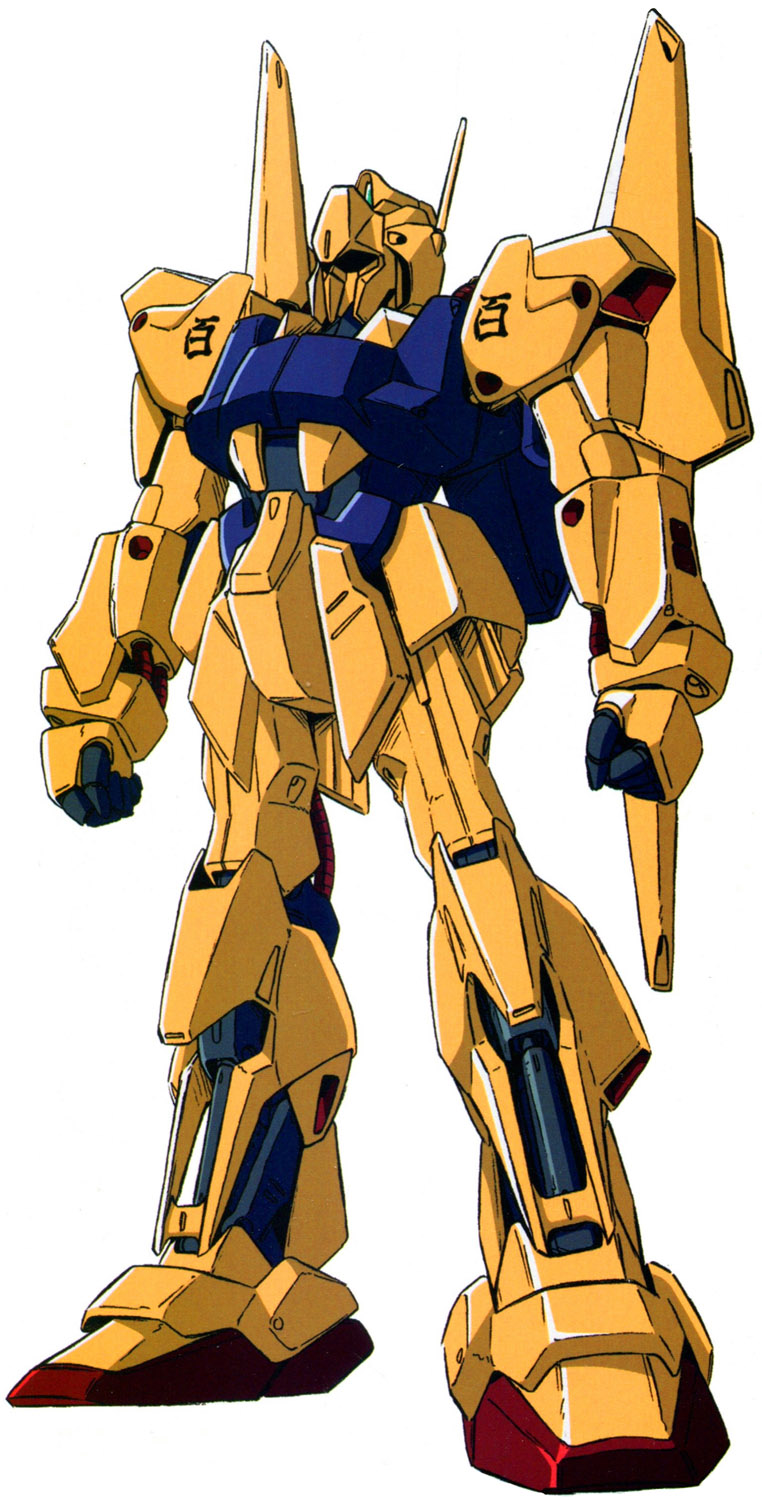Model number: MSN-00100
Code name: Hyaku-Shiki
Unit type: prototype attack use mobile suit
Manufacturer: Anaheim Electronics
Operator: AEUG (Anti-Earth Union Group)
First deployment: UC 0087
Accommodation: pilot only, in panoramic monitor/linear seat cockpit in torso
Dimensions: overall height 19.2 meters; head height 18.5 meters
Weight: empty 31.5 metric tons; max gross 54.5 metric tons; mass ratio 1.44
Armor materials: Gundarium alloy
Powerplant: Minovsky type ultracompact fusion reactor, output rated at 1,850 kW
Propulsion: rocket thrusters: 74,400 kg total (4 x 18,600 kg); vernier thrusters/apogee motors: 12
Equipment and design features: sensors, range 11,200 meters; anti-beam reflective coating on armor
Fixed armaments: 2 x 60mm vulcan gun, mounted in head; 2 x beam saber, power rated at 0.4 MW, stored in recharge racks in rear waist armor, hand-carried in use
Optional hand armaments: beam rifle, power rated at 2.8 MW, powered by rechargeable energy cap; clay bazooka, clip-fed, 7 rounds per clip plus 1 round in chamber; FHA-03M1 Mega Bazooka Launcher
As Anaheim Electronics developed next generation mobile suits under the Anti-Earth Union Group’s Project Zeta flag during the Gryps War, several design proposals were considered for the in-development MSZ-006 Zeta Gundam. One of these proposals, codenamed MSN-001 Delta Gundam, was retooled when its design proved too difficult to incorporate the transformation systems needed for the Zeta Gundam. The design was revised and then constructed as the MSN-00100 Hyaku-Shiki, although it did retain some features that would later be incorporated in the Zeta Gundam, such as the experimental wing binders mounted on its backpack, which packed extra thrusters and aided in maneuverability. Based on combat data and weapons designs from the RMS-099 Rick Dias and MSA-003 Nemo, plus incorporating data and the revolutionary new movable frame concept employed in the RX-178 Gundam Mk-II, the Hyaku-Shiki (Japanese for “type 100”) proved to be a light, fast and highly agile unit. Its armaments included vulcan guns, beam sabers, a beam rifle, a clay bazooka and a massive support weapon called the FHA-03M1 Mega Bazooka Launcher.
The Hyaku-Shiki was assigned to AEUG ace pilot Quattro Bajeena (the incognito Char Aznable – the Principality of Zeon’s “Red Comet” ace from the One Year War). The Hyaku-Shiki was painted in a bright, highly distinctive gold paint scheme – ostensibly as a taunt to the Titans to prove that the AEUG could build mobile suits right under their noses – and had a reflective, anti-beam coating. During the Gryps War, Anaheim also created two variants: the MSR-100S Hyaku-Shiki Kai, which was followed by a version intended (but not used) for mass production. Char used the Hyaku-Shiki as his personal mobile suit until the end of the Gryps War, when it was heavily damaged in a battle against Axis leader Haman Karn’s AMX-004 Qubeley in February UC 0088. Char disappeared after abandoning his nearly destroyed suit, and a second Hyaku-Shiki unit was later assigned to the troupe of young new pilots stationed aboard the AEUG’s assault carrier Argama during the First Neo Zeon War that immediately followed.
Pilot(s): Quattro Bajeena (aka Char Aznable), Beecha Oleg, Mondo Agake, Judau Ashta
First appearance: Mobile Suit Zeta Gundam
Original mechanical designer(s): Mamoru Nagano (principal design), Kazumi Fujita (cleanup)
Director:
Yoshiyuki Tomino
Writer(s):
Hiroshi Ohnogi
Yumiko Suzuki
Tomoko Kawasaki
Yasushi Hirano
Akinori Endo
Miho Maruo
Minoru Onoya
Mechanical Designer(s):
Kazumi Fujita
Mamoru Nagano
Kunio Okawara
Makoto Kobayashi
Kazuhisa Kondo
Hideo Okamoto
Character Designer:
Yoshikazu Yasuhiko
Musical Composer:
Shigeaki Saegusa
Format:
50 episodes; 3 compilation movies
Airdates:
Japan 03.02.1985 – 02.22.1986
Theatrical Release:
Japan 05.28.2005 – 03.04.2006









Comments